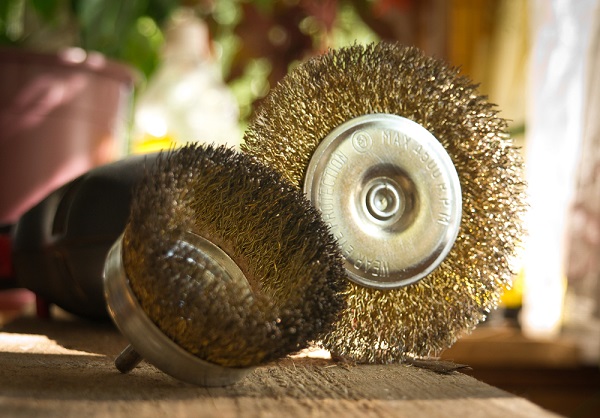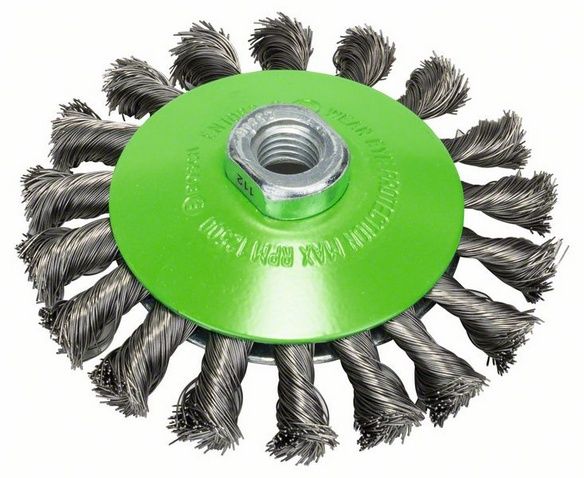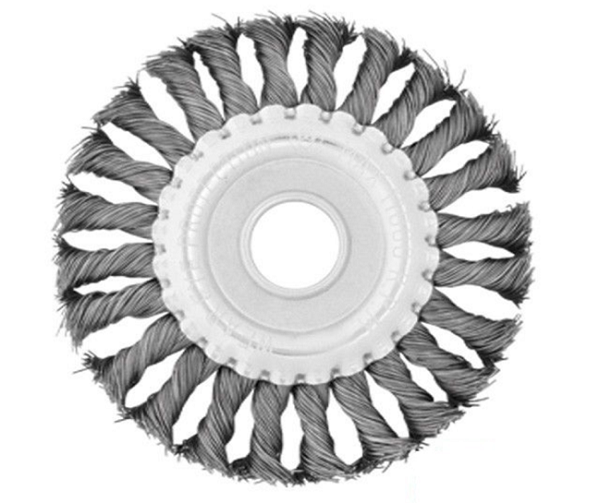Varieties of brushes for the drill
The electric drill is the best assistant at repair work. With it, you can quickly drill holes in concrete or masonry, mix thickened paint or mix the solution. When grinding works, many homemade craftsmen use various nozzles, including brushes for the drill.
Content
Grinding nozzles
A power drill is a versatile tool, and a large assortment of different attachments allows it to be used for different purposes:
- polish metal, wood, glass or paint;
- clean the metal from scale or rust, old paint or primer;
- sanding wood and metal surfaces;
- to clean the sags on concrete when pouring floors.

You can list for quite a long time, it is worth noting that brushes for stripping are in demand everywhere in various areas of human production activity. In some cases, the use of an electric drill with different nozzles has no alternative.
Grinding nozzles on the drill look the same as special blocks for grinding machines, but instead of a threaded connection, they use a pin to fasten it in the tool holder. Their modifications are very diverse: in the form of a cup or plate, butt-end, drum, soft nylon or hard on an abrasive base, shaped like disks or a fan. They are used depending on the power of the instrument and the skills possessed by the worker.
Many homemade craftsmen invent additional tools to fix the drill in the desired position - this greatly facilitates the processing of various parts, especially small size.
Brushes made of metal
Metal brush used as a nozzle for electric drills, has several varieties, so we will tell you in detail about each.
Cup
Cup brush for drill it is used in especially labor-intensive work to clean the surface from various contaminants: welding oxides, corrosion, drops of concrete, mortar or slag. They are used to prepare the surface for painting or applying varnish, rough processing of iron billets.
Excellent process large areas flat steel products at high speed of rotation. They are characterized by such technical parameters:
- diameter - 6.5-15.0 cm;
- conical or end shape;
- if thread is used, then only m10 and m14.

This method allows you to better process the surface of the workpiece. The cup is chosen to be conical in shape, with bristles pressed from it from rather stiff steel wire, and brushes with different lengths are used for better processing. For polishing wood used nylon brush similar design. Initially, using brushes with a not too hard wire, they chop the wood to make it stand out,and then at the fastest speed polish the surface with a nozzle.
Conic
A conical-type brush is applied as a drill bit, and is used in places hard to get toto sweep. Due to the peculiar design, it easily penetrates into such places, performing tasks that are beyond the power of other types of similar attachments.

Disk drive
A disk brush for a drill (often referred to as circular or oval) is used as a drill nozzle, designed to work in particularly hard-to-reach places for treating large areas of surfaces during repair or construction.

The main component of grinding are twisted steel yarn, a scope - processing of welding connections (seams and joints). High-quality polishing gives all the details marketable. Brushes have a very high stiffness and safety margin, the duration of active use.

Main technical indicators:
- diameter: 11.5–20 cm;
- the length of the steel pile is 7 cm; the diameter of the individual threads is from 0.3 to 0.5 mm;
- the thickness of one twisted bundle is 6–20 mm;
- thread: m10, m14;
- The recommended rotation speed during processing is 12.5 thousand rev / m.
For drills, brushes for metal are manufactured using a special technology - the nap is poured with molten plastic, which significantly increases the strength of the product and its intended service life.
In industry, these products are sometimes called brushing, and are used for drills or grinders.
Pick brush
Another rather specific name for this type of nozzles is the drill punch. The brush for a pneumatic industrial drill is used for stripping various parts of rust, flux deposits or during polishing products to give them a presentation. The 6 cm long shank is rigidly fixed in the tool holder, the nylon base perfectly polishes the thin steel sheet, while not allowing it to be damaged due to its softness.
Such drill brushes are used in the production of aluminum radiators for Lanos, Daewoo Matiz and some other brands.

One of the domestic suppliers of such attachments is the factory of mechanized tools from Konakovo city, Tver region. The company has nearly half a century of experience in the production of hand-held electric and pneumatic tools for industrial use.
To the attention of users: pneumatic drills are used for cleaning various surfaces from scale, flux and other raids on the production, which allows to significantly save electricity.
Konakovskoy products supplied to many industrial enterprises of Russia.
Stiffness classes
The production technology of brushes for processing different surfaces provides for various methods and materials for the manufacture of pile:
- steel wire, twisted into bundles;
- brass coated metal thread;
- twisted or crimped surface;
- the pile which is filled in with polymeric structure;
- stainless components.
The main wire has a cross section not higher than 0.5 mm. Thicker diameter is used only for primary processing, "corrugation" and brass wire - for finishing work.
Why the engine sparks
Graphite brushes stand on any electric motor. When the rotor of the electric motor is rotated, the carbon brushes slide along the armature collector, then forming a steady contact with the plates, then breaking it. The normal operation of these elements implies a steady spark, which means that the engine works without problems.From constant friction, these small devices are erased and must be replaced. The waste of such friction is graphite dust, which can settle on the collector - that is why brushes sometimes sparkle strongly.

The causes of the negative effects of dust on the anchor can be eliminated by blowing the inside of the electric motor. Strong sparking - a signal that the brushes occupy the wrong position in the grooves and are erased more than usual. It is necessary to disassemble the drill, get to the brush unit where the brushes are installed, pull them out of the special grooves and check visually the state of the rubbing surfaces - it should be shiny and have a hemispherical recess on the end.
If the brush is worn down to the minimum acceptable value, when it may jam in a groove due to friction, then it is urgently necessary replace such a part on a new one. The design of the brushes is quite simple: a graphite base from which the contact wiring comes out, special non-ferrous metal devices are installed at the end. During work, they move in a special recess. Hassle with them a bit - changed the worn part to a new brush, and the drill again works as before.

/rating_off.png)











